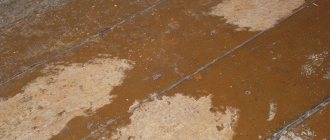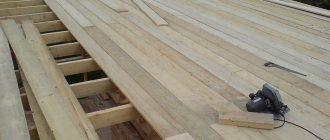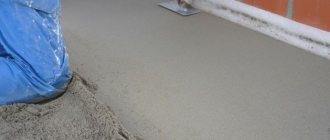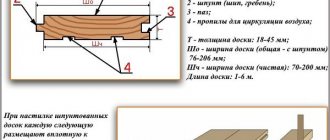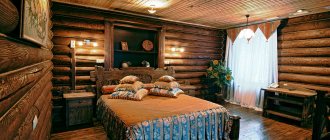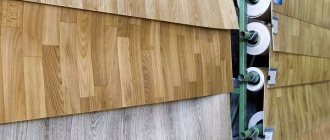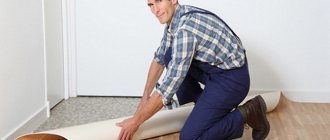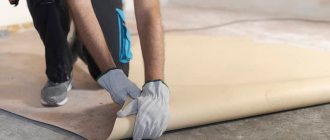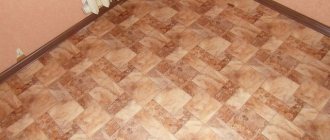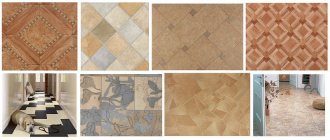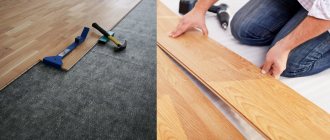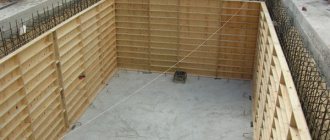Of all the available underlay materials, plywood sheets can rightfully be considered the best option, especially when it comes to laying synthetic flooring. If you lay linoleum on plywood correctly, the floor will last 20-30% longer than if a pressed chip backing was used. In addition, laying linoleum on plywood with your own hands is exactly the case when you can get to work without particularly fearing for the end result.
Plywood is ideal for linoleum
Is it possible to lay linoleum on plywood?
The best solution is not always the most obvious. Plywood doesn't have the best reputation for interior finishing work. Many experts believe that putting linoleum on plywood means dooming yourself to inhaling fumes of phenol and formaldehyde, which are part of the adhesive base. Many craftsmen try, before laying the material under linoleum, to putty the plywood, impregnate it with protective varnishes and adhesive compositions, which supposedly should block the release of harmful fumes.
It is possible and necessary to lay plywood sheets as a solid base under a linoleum covering; moreover, installing linoleum on plywood is quite simple, without any technical problems or problems.
You just need to follow certain restrictions:
- Plywood, like any building part made of wood, is catastrophically afraid of moisture and water condensation, therefore, if you lay the sheets directly on concrete or on an unprotected rough base, without waterproofing and ventilation, then soon linoleum, like the base on which the coating is located, will become , will go in waves;
- Properly laid linoleum reliably protects the room from any fumes. If you use high-quality glue under the linoleum flooring on plywood, then upon completion of the work the plywood floor will separate a protective coating 5-6 mm thick, which will be impossible for any chemicals to penetrate;
- Plywood is a laminated composite, so it is best not to use hot varnish impregnations or bitumen-containing mastics.
Plywood sheets, unlike chipboard and OSB, can withstand enormous dynamic and static loads. Even if you had to lay linoleum on plywood on an old or problematic floor, the plywood backing will additionally strengthen the old coating. Often, plywood sheets were used to repair old wooden floors for which, for technical reasons, it was impossible to replace the load-bearing beams.
Important! The material does not tolerate heating to temperatures above 60-70°C.
Therefore, if you plan to lay a plywood base and linoleum near heating devices or stove ducts, then you need to be prepared for the fact that it is in this place that the glue that glues the veneer of the plywood sheet will sweat out. Of course, fumes may not enter the space of the room, but such heating will negatively affect the durability of both the subfloor and the linoleum itself.
Pros of using plywood as a subfloor
The structure of household linoleum
Linoleum is a soft covering; over time it takes on the shape of the base, so if you do not use a continuous solid flooring underneath it, the finished floor may become uneven with significant differences.
Laying plywood on a wooden floor in this case has the following advantages over other leveling methods:
- creation of a continuous flooring that will not acquire relief over time; no need to dismantle the old covering; reduction in the cost and labor intensity of work (follows from the previous one); availability of material; the possibility of using moisture-resistant types of plywood, which allows you to additionally protect the wooden floor in rooms such as the bathroom, bathroom and kitchen; minimum number of seams between elements, which are the weak point of any design.
What to choose - OSB or plywood for linoleum flooring
Oriented strand board (OSB) is the closest and best known competitor to plywood cores. Now OSB is actively advertised as an inexpensive, reliable and easy-to-work with your own material material. We need to clarify right away - installing linoleum on plywood will cost about twice as much as using OSB.
In addition, the particle board has two undeniable advantages:
- Environmentally friendly material. Formally, OSB is manufactured without the use of special resins and adhesives;
- OSB sheets are less susceptible to moisture. If particle board can be stored simply in a garage, under dry ventilation conditions, then plywood is best hidden in a heated room.
In practice, OSB is in many ways inferior to plywood. Firstly, before laying linoleum on a particle board, you need to remember that special flame retardants and impregnation additives of unknown quality and origin are added to its composition. Secondly, OSB is much worse processed, cut, and sanded. After cutting the sheets, you have to smooth and sand the edges, otherwise the linoleum flooring will end up with protruding chips and splinters. In addition, sheets of plywood and OSB of the same thickness differ in strength and endurance by almost three times. The plywood sheet benefits from its multi-layer and glued structure.
Installation on an insulated cement-sand screed
If you lay OSB on a lumber sheathing and incorrectly calculate the distance between the supports, then after a couple of years cracks will form in the structure of the substrate, sometimes also chips of pressed shavings. Plywood will withstand anything, even if the craftsmen decided to save money and lay a lining layer on bricks instead of timber and boards.
Preparatory work
The most popular material for leveling floors is birch plywood. This raw material has good environmental characteristics and affordable cost. For leveling, plywood sheets of 1525x1525 and 10 mm thick are selected, since such dimensions are the most popular.
If the parts will be laid on top of a concrete screed, experts recommend pre-waterproofing it with a solution or plastic film.
When the floor is wooden, the plywood is laid out both with and without joists. Initially, it is necessary to cut the plywood into convenient sheets.
At the time of fastening, it is necessary to leave small gaps to compensate for thermal expansion. You also need to leave a gap between the plywood and the wall. After laying it, the surface is treated with any primer.
Thickness of plywood for flooring under linoleum
Specific parameters of materials for a plywood base are determined based on where and how, on what rough base it is planned to lay the linoleum. It is generally accepted that when laying linoleum on plywood it will be enough to lay sheets 10 mm thick, but in practice this recommendation is usually adjusted to a larger or smaller amount, depending on the characteristics of the base.
Installation diagram on an uninsulated floor
Choosing sheet thickness when laying plywood on concrete
If the old floor is made in the form of a concrete screed, then it is impossible to glue a plywood sheet onto a cement-sand base; at a minimum, insulation will be required, or even better, double insulation of the plywood from the concrete.
Installation on timber with insulation
It is quite possible to lay plywood sheets on concrete, for example, through wooden slats or any other insulating material. A very rigid solid cement-sand base guarantees good stability of the rough surface under linoleum. Therefore, the thickness of the plywood sheet can be reduced to 8 mm.
Laying material on a self-leveling or wooden floor
For old plank floors, you most often have to use plywood with a thickness of 10-12 mm, no less. Even if the floorboards are in good condition, the laminate plank surface plays a lot under load. A 10 mm plywood sheet can compensate for deflection only if the floorboards are sewn together with nails or are completely repaired, but most often customers prefer not to bother with repairing old boards, but decide to lay a thicker plywood sheet.
Can be laid on tile adhesive
The required thickness is determined, as a rule, based on installation experience. It often happens that 10 mm is not enough to cope with the subsidence of the boards.
Advice! If after covering the plywood the floor remains weak, you can additionally lay fiberboard sheets. They cushion and compensate for deflection.
Glue cannot be installed on heated floors
Marking and adjusting plywood
The sheets must necessarily have a rectangular or square shape.
Most often, plywood 1525x1525 10 mm is adjusted after 2 days from the date of delivery of the material to the site. This is done so that the flooring acclimatizes to the current humidity and temperature conditions of the room. If you follow the technological processes, the plywood sheets should be laid in squares with overlapping joints and offset. The size of the blanks starts from 60×60 cm and more.
The interval between the walls should remain 8–10 mm. It is necessary to cut the plywood in such a way that the maximum floor area is filled with whole panels. Before starting cutting, it is recommended to draw up a diagram of their location. For preparatory cutting work, it is recommended to use an electric jigsaw. Afterwards, rough grinding is performed to remove small roughness.
Is it necessary to glue linoleum to plywood?
One of the problems that we have to face is related to the issue of using glue to fix the linoleum flooring. Everything is clear here, if you plan to lay it on a plywood base, rigidly sewn to slats or an old floor, then it is best to glue the material.
The glue will reduce the slipping of the synthetic fabric, the formation of bubbles and folds on the surface. Of course, only if you lay it on a proprietary adhesive composition. If linoleum is expensive, and even with a lining based on synthetic felt, then you can’t glue it, and you certainly shouldn’t try to lay the coating on cheap “Moment”, “Bustilat” or even PVA-M. These brands are used to glue unlined brands of linoleum, PVC tiles or laminate.
The situation is more complicated when the laid plywood base turned out to be insufficiently rigid. In this case, it is recommended to lay linoleum only with sizing around the perimeter of the room. The linoleum panel is obtained in a free floating state, which significantly improves the resistance of the coating to load.
Some disadvantages of plywood sheets
Despite the impressive list of advantages, plywood is far from an ideal material and has quite significant disadvantages that must be taken into account when using it:
- It is quite flammable. This drawback can be eliminated by impregnating the sheets with a fire retardant solution.
- Hygroscopic, that is, susceptible to moisture. Therefore, it is extremely undesirable to use plywood in rooms where the humidity exceeds 68% for a long time. If there is no other way out, then you should use special moisture-resistant plywood in the bathroom or kitchen. In this case, do-it-yourself impregnation of ordinary sheets with a special composition will help a little.
- Impregnation with an antiseptic is mandatory, since plywood is a favorable environment for the proliferation of various microorganisms and fungi.
- Due to changes in temperature and humidity, the material will experience certain deformations, so it is necessary to have technological gaps between the seams and along the entire perimeter of the coating.
USEFUL INFORMATION: Moisture-resistant gypsum fiber sheets for flooring: board dimensions, application
What kind of plywood to lay under linoleum
If the owners of apartments in multi-storey buildings do not have problems with the choice of material, then the owners of private households most often do not have a clear opinion about what material is best to lay under laying linoleum.
In the first case, according to reviews, plywood under linoleum on a concrete floor can be laid even without treating the floor slabs; it is enough just to insulate the surface with sheets of polystyrene foam or polystyrene foam. If the house is relatively new, then it is best to lay bars on the concrete, and lay insulation in between them. For old buildings, plywood can be laid on a screed under linoleum. You can even use a special dry screed from KNAUF, laid with plywood and forming a very dense and solid base.
Installation on taped joints
For private houses, especially if there is no basement, it is best to use waterproof plywood. No matter how well the floor is insulated and waterproofed, it is impossible to completely stop water vapor from the earthen soil. For houses with a basement, you can lay regular plywood, treated on the back and end surface with waterproof impregnation. If you don’t like fiddling with impregnation, you can lay a laminated one, or make the covering yourself.
Styling tips
Many newcomers to construction wonder whether plywood is needed for linoleum. Experts almost unanimously give an affirmative answer in this case.
Indeed, thanks to this manipulation, there is no need to level the surface before laying the material. Professionals also give practical recommendations that will help simplify the process.1. Before starting work, linoleum must be in the room for at least one day, and preferably two. Thanks to this maneuver, the flooring will get used to the temperature conditions of the given room.2. In the area of doorways and batteries, the material must be laid very carefully, since there it must fit closely.3. After the flooring is completed, it is recommended to leave it alone for several days, and only after this time begin to use it.4. When cutting linoleum in areas near the wall, you need to leave a little margin, since after installation it may shrink slightly.5. In order to fix the covering near the doorway, it is advisable to use double-sided tape.6. Before you start trimming linoleum, you need to level it from the inside, and then roll it into a roll.7. There are two main methods for connecting several sheets of material together: Cold welding method - prepared sheets are installed overlapping, and then, using a knife, the sheets are cut off at the joint.
It is very important to use only a sharp knife for this, since you will need to cut two sheets at once. After this procedure, double-sided tape is placed under them, and they are fixed to it. Next, you need to apply liquid glue to the surface, which will seal the ends together. In order to do hot welding, it is recommended to use a construction hair dryer, which melts a special cord laid at the joint. After this procedure, everything needs to be smoothed out with a smoothing iron.
Linoleum is one of the most common types of coating.
It is practical and affordable, so it has earned mass popularity. If boards act as a subfloor, a problem such as unevenness of the base may arise. This occurs due to the prefabricated structure. Laying plywood over wood floors under linoleum can solve this issue without major effort.
Preparing a plywood floor for linoleum
In order to avoid delamination of the glued material, after the fact, after laying it on a concrete or wooden base, you need to select the sheets as meticulously as possible even at the purchase stage.
We pay attention to the following signs:
- Spots on the front surface;
- Different thickness of material at opposite ends of the sheet;
- There are traces of sandpaper treatment.
Important! All of the above indicates that the material fell under water or even stood in a puddle. Too light and white spots indicate the use of hydrogen peroxide for bleaching, and small roughnesses are traces of attempts to rub over the swollen veneer.
Before laying plywood, the sheets are sorted by quality and degree of compliance with geometry. The flattest ones will be laid in the center of the room, or they can even have tongue and groove joints cut into them - groove and tenon.
The remaining sheets can be laid along the walls; sometimes the material has to be cut into squares and rectangles in order to cut off even and flat areas from those that are too crooked and “behavioured”. The plywood is stacked and loaded with a load before marking work begins.
Sheets of material must be laid at least 2 days before laying the linoleum, it will be necessary to sand the joints with a sander and seal the perimeter with sealant.
Important! Plywood is fastened only with self-tapping screws, and the cap must be recessed into the body at least 1.5-2 mm below the surface level.
Laying on drying oil
What grade of plywood should I choose?
The correct choice of material is the key to preparing a high-quality base for linoleum. What can you do to guide you?
- For any room, not just the bathroom or kitchen, preference should be given to moisture-resistant plywood. It is better to protect yourself from the possible penetration of liquid under the linoleum, and this can happen in any room: moisture can seep out when you wash the floors carelessly, leakage from heating radiators is possible, or something can simply spill. Having saved on material, you can then spend a lot of money replacing swollen floors. Moisture-resistant plywood is marked “FK”.
[smartcontrol_youtube_shortcode key=”choosing plywood for the floor” cnt=”4" col=”2" shls=”true”]
- The thickness of the plywood sheets should not be less than 12 mm if the rough coating is laid in one layer. The greater the expected load on the floors, the thicker the sheet of plywood should be taken. But it should be taken into account that this layer, albeit slightly, will reduce the dimensions of the room.
- Hardwood veneer in plywood sheets allows the latter to withstand higher loads compared to material made from softwood.
- Preference should be given to material polished on both sides. You can also use unsanded plywood marked “NSH”, but it will have to be treated with sanding paper.
Materials such as MDF or OSB are significantly superior to ordinary plywood in their qualities, but they are also much more expensive. If you have a sufficient budget, it is recommended to use them; the financial costs in the future will be more than compensated by the strength and durability of the coating.
- If you doubt that you will be able to impregnate the sheets with the required composition yourself, then it is better not to risk it and buy plywood with factory impregnation, even if it will cost a little more.
Is it necessary to dry plywood under linoleum?
If the flooring is to be laid on the floor in a guest house, summer cottage or in any other room where people do not live permanently or where there is no heating, then it will be useful to impregnate the plywood under the linoleum with a protective compound.
Drying oil protects “fresh” wood well, which has not yet been exposed to water or any other liquids. Plywood can be processed on the back side and on the ends. Dry the material only in the sun, at a temperature of 25-30°C. If there are no such conditions, then it is best to use more modern protective materials. The front side is not processed.
Even 20-25 years ago, before laying linoleum, the floor was necessarily oiled, after which the floor covering was laid, without even waiting for the film to dry completely. Drying oil served both to protect against moisture and at the same time to fix the canvas. It was easy to lay, but it was impossible to remove the linoleum from such a surface, since the linen was tightly stuck to the plywood.
Material selection
In order for the final result to be pleasing to the eye, it is necessary to choose the right rough coating. The thickness of the sheets should be in the range of 10–22 mm. Plywood of 10 mm is the minimum acceptable value for such sheets, but it is recommended to use it extremely rarely. After all, it may not withstand significant loads.
When choosing the thickness of the material, you need to remember the traffic flow of the room and the weight of the furniture that is installed. The greater the load, the greater the thickness you need to choose. It is strongly recommended to give preference to moisture-resistant wood, which will not deform or change its shape in wet rooms. Although linoleum does not allow water to pass through, the joints and seams between the sheets remain weak points. To successfully install plywood under linoleum, you will need the following equipment: level; jigsaw; marker; tape measure; screwdriver; screws; backing; broom or construction vacuum cleaner. You may also need a roller , primer, sander, sealant and glue.
How to treat plywood before laying linoleum
If possible, it is best to use modern varnish materials. They are inferior to drying oil in terms of environmental friendliness, but they make it possible to more effectively protect not only plywood, but also the subfloor.
Varnish coatings
Oil-based, polyurethane and pentaphthalic varnishes with a small addition of thinner are applied with a roller or brush. The varnish film is thin enough not to affect the glue between the veneer layers, and at the same time dense enough to effectively block even water vapor. You can lay linoleum on plywood no earlier than after 3 days.
The varnish reliably protects the coating
Silicone oil
The use of special aerosol silicones is very convenient when it comes to laying the floor in the shortest possible time. Plywood is processed from the back and end surfaces; if you lay linoleum without glue, you can apply one layer to the front part of the floor.
Silicone oil is the best at repelling water and condensation without preventing water vapor from escaping from the wood. The method can be very useful for unheated rooms.
How to lay plywood on a concrete screed?
First you need to check the floor with a level. The maximum permissible discrepancy should not exceed 2 mm. Then the base is carefully prepared. Using a vacuum cleaner, all debris and dust are removed, the room is de-energized, and then the surface is washed with warm water. After drying, you need to cover the concrete screed with a thin layer of bitumen varnish or putty.
Ideally, after drying, it is necessary to lay a thin waterproofing film. It is laid with slight tension and fixed at the edges with special glue. After the glue has set, you can begin laying the plywood.
Figure 1. All fitted sheets are numbered according to their arrangement.
First, prepare identical squares. After this, you need to lay the plywood in a rough version. That is, do not attach it to the floor, but simply put it the way you want to see it in the future (Fig. 1). At the same time, do not forget that the squares must be laid with overlapping seams.
After numbering, final installation can be done. The best option is to fasten the plywood using “liquid nails” or glue special for this purpose. Bustilate can also be used. But it is undesirable to use self-tapping screws in this case. After setting, the linoleum floor is ready!
Related article: What is the best way to caulk a log house?
Technology of laying linoleum on plywood
Formally, the installation process consists of two stages:
- Cutting the material;
- Laying and trimming linoleum after the adhesive base has set.
Unlike other types of flooring, linoleum is cut into separate panels outside the room. For example, it is easier to cut pieces from a roll in the courtyard of a house, especially if the width of the material is more than 3 m.
Advice! When planning cutting, it is important to ensure that the joint between the panels does not coincide with the seams between the panels. If it matches, then you need to remove it and lay it offset.
The cut parts are brought into the house, before laying the material, adhesive tape is pasted around the perimeter of the room, which helps keep the covering on the floor during installation and fitting.
The next step is to apply glue; it is best to apply the adhesive material in strips every 25-30 cm. This method allows you to safely lay linoleum and at the same time avoid the appearance of bubbles due to excess glue. The coating is carefully rolled with a rubber roller to squeeze out excess adhesive mass. After two days, you need to trim the edges and cut the joints between the panels.
Surface inspection and preparation
Any surface requires preparation before reconstruction, and wooden floors are no exception:
- Skirting boards are removed if they are present on old floors.
- Waterproofing and the presence of moisture sources are checked. Without eliminating the latter, it is pointless to lay plywood; they will fail in a fairly short period of time.
USEFUL INFORMATION: How to paint wooden floors in an apartment: review of materials
- Replace rotten or damaged elements.
- In old floors, it is permissible to have gaps up to 5 cm in size. If the gaps between the boards are larger, then they need to be eliminated.
- If there are significant differences in height between the floorboards, grinding will have to be done, otherwise such relief will subsequently appear on the surface of the linoleum. To do this, you need to rent a grinding machine.
Before grinding, all metal elements are removed or recessed so as not to damage the abrasive. Loose floorboards are secured using wedges, nails or self-tapping screws. Sand the floors diagonally, making overlapping strips and not holding the machine in one place.
In addition to the base, you also need to prepare the plywood sheets themselves. First of all, you need to let them sit indoors for at least three days. If you plan to impregnate the plywood, then you need to allow time for it to dry.
Impregnation of plywood with polyvinyl acetate putty has become widespread as a relatively cheap but reliable way to protect plywood sheets. You should also remember to treat the material with an antiseptic.
How to glue linoleum to plywood
Thanks to the clean and polished surface of the veneer, both PVA and special polyurethane compounds can be glued with equal success. Birch, pine or linden absorbs water well, so it is best to choose glue with a minimum water content for plywood for linoleum.
Any adhesive material designed for laying PVC on wood will do. In addition to polyurethane and styrene compositions, acrylic and isoprene mastics can be used. It takes 50-70 minutes to lay linoleum on glue.
You can trim the edges only after the center is securely fixed.
Advice! Don’t even try to lay linoleum on polyurethane foam. Despite excellent adhesion and high strength, PU foam expands after laying for at least several more hours.
As a result, the linoleum rises with bubbles, even after rolling the sheet onto the plywood three times.
Laying sheets
The cut sheets are laid out on the floor for fitting. It is better to number them and draw up a simple diagram of their location, so as not to suffer later when selecting the right element.
- Before applying the glue, the surface is cleaned of dust and degreased with white spirit. A layer of glue no more than 2–3 cm thick is evenly applied to the floor surface.
You can use special wood glue or home-made mastic: PVA is mixed with gypsum until the consistency of thick sour cream. You should try to smooth out the unevenness and fill the cracks with the adhesive solution.
- Sheets of plywood are glued according to the laying diagram, their level is controlled, after which it is necessary to allow the adhesive solution to set. This will take 1–2 days.
- After the glue has dried, additional fixation is performed with self-tapping screws. They should be placed no closer than 20 cm from the edge of the sheet in increments of 15–25 cm. To prevent the heads of the screws from showing through after laying the linoleum, they should be recessed, for which it is better to first countersink the holes.
- At the final stage, all joints are sanded and smoothed with wood putty. You can use PVA glue mixed with plaster or small wood shavings. The holes in the sheets where the screw heads are located are also puttied.
The process of laying plywood sheets is shown in more detail and clearly in the video.
After the putty has dried, the surface is cleared of any debris that has formed and linoleum is laid on it.
How to lay linoleum on plywood
The only important condition is to ensure waterproofing of the seams and edges of the fabric at the walls and at the entrance. Usually they try to lay linoleum by rolling out a roll from the far wall towards the front door.
It is most convenient to glue if the width of the canvas does not exceed two meters. In this case, the glue can be applied and stretched in strips perpendicular to the line of laying the coating. After rolling out, you have to stretch the linoleum using a plastic spatula, similar to what is done when gluing wallpaper. It’s not enough to lay the canvas; you also need to properly roll it onto the plywood. The coating is ironed towards the exit and side edge.
The higher the air temperature in the room, the easier it is to lay linoleum on plywood, the glue dries faster and the canvas itself seems much softer.
Installation features
If the old wooden covering is removed, then install the joists before laying the plywood.
The plywood under the linoleum is laid on the joists when the wooden covering is dismantled.
After removing the old flooring from the floor lath, the joists are left in satisfactory condition for further use. Using a laser level, we check the top edge of the joist for horizontalness, and also measure the distance between each element for comparison with the dimensions of the cut sheets of the product.
If the plywood sheets are laid on less than 2-3 logs, increase the number of the latter, reducing the gaps between them. We insert jumpers from boards between the joists and fasten them with self-tapping screws. We install the jumpers one from the other at a distance the size of the side of the plywood sheet.
We check the assembled base for horizontality using an aluminum rule with a level. We protect the wooden frame from moisture using an antiseptic.
For thermal insulation and sound insulation of the floor, between the joists we lay stone wool slabs with films that protect the insulation from moisture. We fasten the prepared sheets of the product with self-tapping screws to the frame.
How to lay plywood on a wooden floor when removing the covering is not practical. If no defects are found after checking the floor covering and joists, we use a base for laying the subfloor made of plywood.
The level will help check the correct assembly of the floor
We check the horizontal surface of the wooden floor using a laser level. Loose boards are additionally secured with self-tapping screws. We go over the warped floor slats with a plane and remove any uneven surfaces. To close the gap between the slats, use silicone sealant.
If the surface of the old floor does not have horizontal deviations, cover the base with a primer. Cover the floor with plywood over the dried primer. We lay the sheets of the product according to the previously described scheme, securing the plates to the base with self-tapping screws.
An important point before laying plywood is to study the characteristics of the material included in the table.
| The name of indicators | Brand FC | Brand FSF | Brand FBS |
| Flexural strength (Mpa) | 25 — 30 | 40 — 60 | 78 — 90 |
| Tensile Strength (Mpa) | 30 | 40 | 68 — 88 |
| Moisture resistance (%) | 9,3 – 10,4 | 6 — 10 | 6 |
| Thermal conductivity (W/m*K) | 0,11 – 0,147 | 0,09 – 0,24 | 0,09 – 0,24 |
In order to choose the right products for the base under a linoleum coating, we understand the properties of the product, focusing on strength, water resistance and the presence of glue and formaldehyde in the composition, used in manufacturing.
We find out who the plywood manufacturer is and whether there is a certificate for the product.
Advantages
Using such a wooden base has a number of advantages:
- formation of a single flooring that does not acquire relief over time;
- there is no need to dismantle the old coating;
- the cost of rough work is removed;
- low price of material;
- the use of moisture-resistant types of plywood, which makes a similar method available for the bathroom, bathroom and kitchen.
Linoleum
264 votes
+
Vote for!
—
Vote against!
Using plywood as a subfloor helps to quickly and efficiently level any floor covering. Installing linoleum on a plywood floor is an excellent option for finishing the floor, as this process does not take much time and is easy to complete. However, installing linoleum on a plywood base has its own characteristics and requires compliance with a certain technology. We'll look at how to lay linoleum on plywood below.
Table of contents:
- Linoleum - characteristics and advantages of the material
- Types of linoleum for laying on plywood
- Technology for laying linoleum on plywood: preparatory work
- How to lay linoleum on plywood: methods of laying linoleum
- Recommendations for laying linoleum on a plywood base
Linoleum - characteristics and advantages of the material
The popularity of linoleum is explained primarily by its availability, good performance characteristics and low cost. Linoleum is the most economical and popular floor covering, which has good thermal insulation characteristics.
In addition, the variety of linoleum patterns allows it to be used in any room. Thanks to this, linoleum has a very wide range of applications. It is used for finishing floors in residential, public and industrial premises.
Linoleum perfectly imitates wood, stone, glass, ceramics, tiles and other materials. Thanks to this, it fits into any type of interior. Among the main advantages of linoleum we highlight:
- easy installation - installation of linoleum does not require special equipment or special skills to work with it; even one person can install linoleum;
- ease of operation and maintenance - this material is easily cleaned from dirt, so its use is relevant in rooms with high traffic; to clean linoleum, it is enough to use warm soapy water;
- does not require the application of protective compounds, like parquet;
- soft, but at the same time durable and elastic, these qualities give linoleum high tensile strength and resistance to mechanical damage;
- due to the fact that the service life of linoleum is several decades, this material is distinguished by its practicality and long service life;
- moisture resistance, allows you to install linoleum in rooms with medium and high humidity levels, such as the kitchen, bathroom;
- another advantage of linoleum is its resistance to acid and aggressive chemicals;
- linoleum has high heat and sound insulation characteristics;
- linoleum has a low level of slipping, thanks to this, people who move on it are safe, thus, linoleum is widely used for installation in the kitchen, in the gym or in public spaces;
- linoleum is perhaps the most diverse material in terms of colors; it imitates other types of coatings and is distinguished by diverse patterns and the most unusual colors;
- with the help of linoleum it is possible to equip a heated floor system;
- affordable cost is the first factor ensuring the popularity of this finishing material.
Linoleum has many advantages, but it still has certain disadvantages:
- laying linoleum requires a perfectly flat base; a subfloor made of plywood is an ideal option;
- Installing heavy furniture on a linoleum surface leads to the formation of dents on it.
However, if we compare the advantages and disadvantages of this material, it is obvious that it has much more advantages.
Types of linoleum for laying on plywood
Among the main types of linoleum are:
1. Household version of linoleum - a foamed polyester base is used for its production; a strip of such linoleum is from one to four millimeters in thickness. However, this type of linoleum has a complex structure. Among its advantages, the following should be highlighted:
- variety of color solutions;
- high level of softness;
- moisture resistance;
- easy styling;
- affordable price.
However, if this type of linoleum is subject to high operational load, then its service life is about three years. This material is unstable under heavy weight, and therefore, due to its softness, is prone to the formation of dents. This version of linoleum is recommended for use in residential premises.
2. Commercial version of linoleum - characterized by high wear resistance and long service life. Excellent for installation in offices or salons, as it involves applying any kind of emblems or drawings to it. There are two options for this linoleum:
- homogeneous type linoleum;
- heterogeneous type linoleum.
The first option differs in thickness from one and a half to three millimeters. It has a monochromatic design and contains components in the form of limestone, talc and kaolin. A special polyurethane coating is applied to the surface, protecting it from mechanical and external influences. Once every six months, this coating needs sanding.
The second version of linoleum is heterogeneous and is highly versatile. It has a multilayer structure and is based on the use of fiberglass. To impregnate the front part of the linoleum, PVC paste is used, then a pattern is applied to the linoleum, which is secured with another layer of polyvinyl chloride. A backing made of fabric, jute or foamed polyvinyl chloride is laid on the inside of the linoleum. This linoleum does not require special care and has a long service life.
3. Semi-commercial linoleum - similar to the household type of linoleum, but differs in a higher thickness of the protective layer, about 0.6 mm. The scope of its application is related to public and public spaces.
In relation to the type of materials used in the production process of linoleum, it is divided into:
- synthetic linoleum;
- natural linoleum.
The first option is characterized by ease of maintenance, moisture resistance, and good sound insulation characteristics. However, this linoleum has one drawback - the use of synthetic resins in its production process.
The natural version of linoleum is environmentally friendly to human health. It is resistant to wear, deformation and abrasion. To make modern natural linoleum, linseed oil, resin, jute fabric and natural-based dyes are used. To ensure the protection of linoleum, a polymer coating is applied to it.
Due to the presence of linseed oil in its composition, linoleum has bactericidal characteristics; in addition, such linoleum has a high level of fire safety. It is easy to clean and does not change color when exposed to ultraviolet radiation. This linoleum is not used in places with increased operational load or in rooms with high levels of moisture.
Technology for laying linoleum on plywood: preparatory work
Laying plywood on a wooden base is done in order to completely level it. If you don’t do this and lay linoleum on an uneven floor, it will soon take its shape and become uneven too. The result will be an aesthetically unattractive coating.
Even if a wooden floor is smooth, it can creak, and laying plywood on it will avoid this unpleasant process. Before starting work, you should determine the location where the logs are installed, if any. To do this, one board is torn off the floor. Then, using long self-tapping screws, the floor begins to rotate. Please note that none of the boards should be loose. The screws should be of such length as to ensure a tight fit of each board. The distance between the concrete floor and the screws should be at least ten centimeters. To fill the cracks, wooden wedges or polyurethane foam are used.
The most popular material for leveling floors for laying linoleum is birch plywood. To make it, veneer layers are used, glued together. This material is affordable and has good environmental characteristics. To level the floor with plywood, choose a material about one centimeter thick. The price of the material depends on its thickness and the wood used in its manufacturing process.
After checking and preparing the subfloor, the plywood installation process follows. If plywood is laid on top of a concrete screed, it is recommended to pre-waterproof it with plastic film.
Plywood is laid on the floor either with or without joists. Before starting work, you should cut the plywood into sheets that are convenient for fixing to the floor. It is most convenient to cut large sheets into four parts. Leave small gaps between sheets to compensate for thermal expansion. In addition, a gap of 1-1.5 cm is also left between the wall and the plywood. Fasten the plywood in a checkerboard pattern; after laying it, treat the floor with a primer or primer. Using the rule, check the base for evenness.
How to lay linoleum on plywood: methods of laying linoleum
There are two options for laying linoleum on plywood:
1. Glueless installation of linoleum - after preparing the plywood base, the process of laying linoleum follows. If the area of the room is from twelve to fifteen square meters, then this installation method is the most optimal and suitable.
However, if the room has high traffic, it is still recommended to use the second method. If you lay linoleum in a large room using the glue-free method, then over time there is a risk of its deformation and swelling. In order to lay linoleum on a plywood base efficiently and with maximum evenness, follow a number of steps:
- after purchasing linoleum, leave it indoors for at least a day to acclimatize it;
- roll out the roll in another room, the area of which is larger than that in which it will be laid;
- in relation to the measurements of the room, cut out a piece of linoleum for installation, leave a margin of 50-100 mm on each side;
- roll out the cut out fragment in the room so that its stock extends beyond the walls evenly on all sides;
- starting from the central part of the room, level the linoleum moving towards the edges;
- using a sharp utility knife, trim off the excess linoleum, retreating one centimeter from the wall;
- To fix the linoleum on the floor, use plinths, and install a steel strip in the form of a threshold on the threshold.
2. The second option for laying linoleum will tell you how to glue linoleum to plywood, since it involves gluing linoleum to the floor surface.
At the beginning of work, the linoleum is also cut in relation to the parameters of the room. For these purposes, use a sharp knife. Lay the linoleum sheets on the floor, check their compliance with the shape of the room.
Bend down half of the linoleum and coat it with glue. To apply glue, use a special grater or toothed spatula. Next, wait as long as indicated in the instructions for the glue that is applied to the linoleum, lay the linoleum on the floor, carefully leveling it. Make sure there are no air bubbles on the glued sheet of linoleum. Do the same with the second half of the linoleum; if you plan to install several linoleum sheets in the room, then they are overlapped, and then cut with a knife and welded using the hot or cold welding method and special equipment.
Tip: When choosing an adhesive composition for laying linoleum on a plywood base, you should not settle on PVA glue or water-based compositions. Since during the operation of linoleum, there is a risk of plywood settling and swelling of the material. It is better to give preference to compositions intended for wooden surfaces.
Another option for gluing linoleum to the surface is to use double-sided tape. Among the advantages of this installation method it should be noted:
- ease of implementation;
- ease and low cost of work;
- such linoleum is easier to remove than glued with glue;
- reliable fixation of the coating.
Double-sided tape is glued to the plywood floor around the perimeter of the entire room. In addition, tape must also be applied to the joint areas.
Recommendations for laying linoleum on a plywood base
1. Before starting work, the linoleum should be in the room for at least a day, or better yet two, so it will get used to the temperature and humidity conditions of the room.
2. Particular care should be taken when laying linoleum near radiators, doorways and niches; it should fit closely to them.
3. After laying the linoleum, if possible, leave it for one or two days, and only after the specified period has passed, begin to use it.
4. When cutting linoleum in areas near the walls, leave a little margin, since linoleum shrinks slightly after installation.
5. To fix the linoleum near the doorway, use double-sided tape.
6. Before cutting linoleum, turn it inside out and roll it into a roll.
7. In order to connect two sheets of linoleum together, there are two ways:
- cold welding method - install sheets with overlap and use a knife to cut the linoleum at the joint, attention - use only a sharp knife, since you need to cut two sheets of linoleum at once, then apply double-sided tape under the linoleum sheets, fixing them on it, apply to the surface material in the form of liquid glue, it will connect the ends together;
- using hot welding, a construction hair dryer is used, which heats up a special cord, which is immediately laid at the joint and smoothed with a special smoothing iron.
